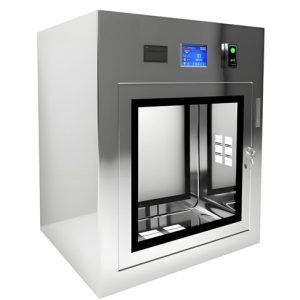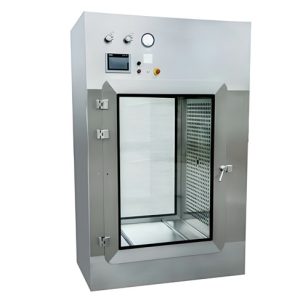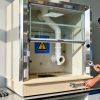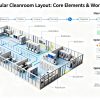Account
-
Safe payment options
We only work with the most secure payment systems.
-
Product return within 30 days
We do our very best to keep our customers happy.
No products in the cart.
You dont have any products in your cart yet, add a few products to experience this experience.
Add $500.00 to cart and get free shipping!
To see and take advantage of all discounted products.
Click HereModular Cleanroom Filter Replacement schedule – Influencing Factors and Optimization Strategies
Table of Contents
Types of Cleanroom Filters & Their Functions
Filter Classification System
- Pre-filters (G4/F5): Capture large particles (5-25 microns) with 80-90% efficiency, serving as the first line of defense and extending the life of subsequent filters by 40-60%
- Medium Efficiency Filters (F7-F9): Remove medium-sized particles (1-10 microns) with 85-95% efficiency, providing intermediate protection
- HEPA Filters (H13-H14): High-Efficiency Particulate Air filters capture 99.97-99.995% of particles at 0.3 microns, representing the core filtration stage
- ULPA Filters (U15-U17): Ultra-Low Penetration Air filters achieve 99.9995% efficiency at 0.12-0.25 microns for ultra-clean applications
- Chemical/Molecular Filters: Specialized media for removing gaseous contaminants, VOCs, and molecular contamination in semiconductor and pharmaceutical applications
Multi-Stage Filtration Architecture
Modern modular cleanrooms employ a sophisticated cascade filtration approach where air passes through progressively finer filter stages. For instance, in a typical ISO Class 6 pharmaceutical cleanroom, the air pathway follows: External Air → Pre-filter (G4) → Bag Filter (F7) → HEPA Filter (H13) → Protected Workspace.
This staged filtration strategy, recommended by Deiiang™ engineers including product designer Jason.peng, extends HEPA filter lifespan by 50-80% compared to single-stage systems, significantly reducing the frequency of modular cleanroom filter replacement interventions and associated operational disruptions.
Particle Capture Efficiency by Filter Type
Efficiency measured at most penetrating particle size (MPPS)
Key Factors Influencing Filter Replacement Schedule
Multiple operational and environmental variables significantly impact the optimal modular cleanroom filter replacement schedule, necessitating a customized approach rather than generic time-based intervals. Understanding these factors enables more accurate lifespan predictions and cost optimization.
1.Cleanroom Classification
Higher classification cleanrooms (ISO 5-6) typically experience 3-5x higher air changes per hour (ACH), accelerating filter loading. For example, an ISO Class 5 cleanroom operating at 400-600 ACH will require HEPA filter inspection every 6-9 months, compared to 12-18 months for ISO Class 8 facilities at 20-40 ACH.
2.Operating Environment
External air quality dramatically impacts pre-filter service life. Facilities in urban industrial areas (PM2.5 > 35 μg/m³) may require monthly pre-filter changes, while rural locations (PM2.5 < 10 μg/m³) can extend intervals to 3-4 months, representing a 67% reduction in replacement frequency.
3.Operational Intensity
Continuous 24/7 operations accumulate particulate loading approximately 3.5x faster than single-shift operations. Filter life calculation: Rated Life (hours) = Manufacturer Rating × (8 / Actual Operating Hours per Day) × Environmental Factor (0.6-1.4).
3.Process Contaminant Generation
Internal processes significantly impact filter loading. Semiconductor etching operations may generate 5-8 mg/m³ of submicron particles, while pharmaceutical vial filling might produce only 0.5-1.2 mg/m³, creating a 6-8x difference in filter loading rates.
ISO Classification Impact on Filter Replacement Frequency
Economic Impact Analysis
A Deiiang™ client operating a 800 m² ISO Class 7 modular cleanroom optimized their modular cleanroom filter replacement schedule by implementing environmental monitoring and predictive analytics, extending HEPA filter life from 3.2 to 4.8 years. This single optimization saved $28,500 annually in direct filter costs and reduced maintenance downtime by 120 hours per year.
How to Determine When to Replace Filters
Implementing a data-driven approach to modular cleanroom filter replacement decisions requires multiple monitoring methodologies rather than relying solely on calendar-based schedules. The following parameters provide objective criteria for replacement timing.
4.1 Differential Pressure Monitoring
Pressure differential across filters serves as the primary indicator of particulate loading. As filters accumulate contamination, resistance to airflow increases proportionally. Most manufacturers recommend replacement when ΔP reaches 1.8-2.2x the initial clean value.
Practical Example: A new HEPA filter installation shows initial pressure drop of 125 Pa. The replacement threshold would be triggered at 225-275 Pa. In a typical Deiiang™ modular cleanroom application, this threshold is typically reached after 12-24 months of operation, depending on environmental conditions.
Filter Lifecycle Pressure Profile
4.2 Particle Count Monitoring
Real-time particle monitoring provides direct evidence of filter performance degradation. A sustained increase of 15-25% in particle counts at critical monitoring locations typically indicates filter bypass or media failure, necessitating immediate investigation.
4.3 Airflow Velocity Monitoring
Reduced airflow velocity below design specifications indicates excessive filter loading. For unidirectional airflow applications, velocities dropping below 0.35 m/s (ISO 5 requirement: 0.45 m/s ±20%) signal the need for filter inspection and potential replacement.
4.4 Energy Consumption Analysis
Filter loading increases system resistance, forcing fans to consume more energy. A 50% increase in pressure drop typically correlates with a 15-20% increase in energy consumption, providing both operational and economic replacement indicators.
Typical Filter Replacement Schedules & Guidelines
The following comprehensive guidelines provide baseline expectations for modular cleanroom filter replacement intervals. However, these should be continuously refined based on facility-specific monitoring data and operational parameters to optimize the modular cleanroom filter replacement strategy.
Comprehensive Filter Replacement Schedule Guidelines
Lifecycle Cost Optimization Analysis
A detailed study conducted by Deiiang™ across 12 modular cleanroom facilities demonstrated that optimizing the modular cleanroom filter replacement schedule based on actual performance data rather than fixed intervals reduced total cost of ownership by 28-42%. For a typical 500 m² ISO Class 7 facility, this translated to annual savings of $18,500-$27,800, with payback periods for monitoring equipment investments of 8-14 months.
The analysis further revealed that the most significant savings came from extending HEPA filter life through improved pre-filter maintenance and environmental controls, highlighting the interconnected nature of filtration system components in the overall modular cleanroom filter replacement ecosystem.
Best Practices & Considerations for Filter Replacement
6.1 Proactive Maintenance Planning
Develop comprehensive maintenance schedules incorporating predictive analytics based on historical performance data. Implement condition-based monitoring with clear escalation protocols for replacement decisions.
6.2 Qualified Technician Training
Filter replacement should be exclusively performed by IEST-certified technicians following documented procedures. Deiiang™ requires minimum 40 hours of specialized training for filter handling personnel.
6.3 Contamination Control Protocols
Implement rigorous contamination control measures during replacement operations, including temporary containment barriers, negative pressure enclosures, and continuous particle monitoring during the procedure.
6.4 Integrity Verification Testing
Conduct comprehensive DOP/PAO testing after each HEPA/ULPA filter replacement, scanning the entire filter face, frame seals, and grid system. Document all results for regulatory compliance and trend analysis.
Filter Replacement Procedure Checklist
Pre-Replacement Phase
- Review historical pressure differential data
- Verify replacement filter specifications and certifications
- Prepare clean tools and replacement equipment
- Schedule production downtime with adequate buffer
Replacement Execution
- Isolate filter housing from airflow system
- Remove old filter using double-bagging technique
- Thoroughly clean filter housing surfaces
- Install new filter with proper gasket alignment
Post-Replacement Verification
- Conduct integrity test (DOP/PAO scan)
- Verify pressure differentials within specification
- Perform particle count verification
- Update maintenance records and documentation
Regulatory Compliance Considerations
All filter replacement activities must comply with relevant regulatory standards including ISO 14644, EU GMP Annex 1, and FDA guidance for sterile products. Documentation should include filter serial numbers, installation dates, integrity test results, and technician certifications. Deiiang™ maintains comprehensive documentation templates that satisfy these requirements while streamlining the modular cleanroom filter replacement documentation process.
Consequences of Neglecting Filter Replacement
Contamination Events & Product Loss
Compromised filtration leads directly to particulate contamination, potentially ruining entire production batches. In pharmaceutical applications, a single contamination event can result in product losses exceeding $250,000, not including regulatory implications and recall expenses.
Regulatory Non-Compliance
Failure to maintain proper filter performance violates multiple regulatory standards, potentially resulting in Form 483 observations, warning letters, suspension of manufacturing licenses, and delayed product approvals with significant financial impacts.
Energy Inefficiency
Clogged filters increase system resistance exponentially. A 50% increase in pressure drop typically increases energy consumption by 15-20%, adding $3,500-$8,000 annually to utility costs for a medium-sized cleanroom facility.
Equipment Damage & Premature Failure
Excessive system pressure stresses fans, motors, and ductwork, reducing equipment lifespan by 30-50% and increasing unexpected failure risk. Emergency repairs typically cost 3-5x more than planned maintenance.
Quantified Risk Assessment
A comprehensive analysis by Deiiang™ of 27 cleanroom facilities revealed that deferred filter replacement increased total operational costs by an average of 42% compared to proactive maintenance schedules. The most significant cost drivers were product loss (58% of additional costs), emergency maintenance (23%), and increased energy consumption (19%). This data underscores the critical importance of a disciplined modular cleanroom filter replacement strategy.
Frequently Asked Questions
Can HEPA filters be cleaned or refurbished instead of replaced?
No, HEPA and ULPA filters cannot be effectively cleaned or refurbished without compromising their integrity and efficiency. The delicate glass fiber media is easily damaged by cleaning attempts, and any compromise to the filter structure can create bypass pathways for contamination. Replacement with certified new filters is the only acceptable practice for critical applications.
What is the typical timeframe for complete filter replacement in a modular cleanroom?
For a standard modular cleanroom, pre-filter replacement requires 15-45 minutes per filter bank. HEPA/ULPA replacement with proper integrity testing typically requires 2-4 hours per filter bank. A complete system replacement for a 500 m² facility generally takes 2-3 days, including verification testing and documentation. Deiiang™ technicians have optimized this process to minimize production disruption while ensuring compliance.
How does optimizing our modular cleanroom filter replacement schedule impact operational costs?
Proper optimization typically reduces total filter-related costs by 25-40% annually while improving system reliability and compliance. A detailed cost-benefit analysis from Deiiang™ for a specific 750 m² facility projected annual savings of $32,500 through extended filter life, reduced energy consumption, and minimized production disruptions. The return on investment for implementing advanced monitoring systems is typically achieved within 8-16 months.
What documentation is required for regulatory compliance after filter replacement?
Comprehensive documentation must include: filter manufacturer certificates, efficiency certifications, installation dates, integrity test results (DOP/PAO scans), pressure differential readings before and after replacement, particle count verification, and technician certifications. Deiiang™ provides complete documentation packages that satisfy ISO 14644, EU GMP, and FDA requirements, ensuring audit readiness.
Conclusion & Call to Action
Implementing a scientifically-grounded, data-driven modular cleanroom filter replacement schedule is fundamental to maintaining cleanroom integrity, regulatory compliance, and operational efficiency in modular facilities. The modular cleanroom filter replacement approach must be customized to specific operational parameters and continuously refined based on performance data rather than relying on generic time-based intervals.
A proactive, optimized modular cleanroom filter replacement strategy delivers substantial benefits beyond mere compliance, including significant cost reductions, enhanced product quality, and minimized operational disruptions. The modular cleanroom filter replacement program should be integrated as a core component of your facility’s quality management system, with clear accountability, comprehensive documentation, and continuous improvement mechanisms.
Transform Your Filter Management Strategy Today
Partner with Deiiang™ for a comprehensive assessment of your modular cleanroom filter replacement requirements. Our certified experts, including product designer Jason.peng, will develop a customized, data-driven maintenance plan that maximizes filter performance while optimizing operational costs.
Limited Time Offer: Download our premium Filter Replacement Optimization Toolkit including customizable scheduling templates, cost-benefit calculators, and regulatory compliance checklists.









